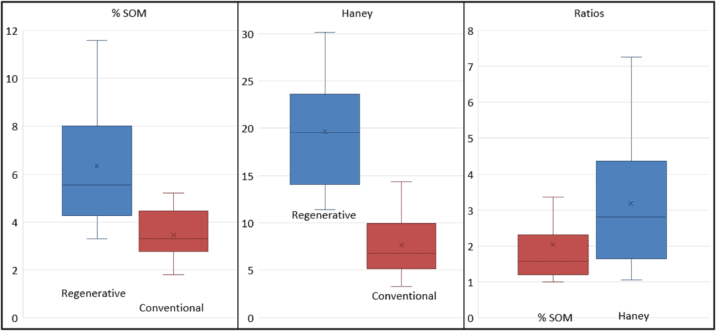Are regeneratively raised foods healthier?

The connection between our food production and human health is complex, but the emerging evidence is clear: agriculture and human health are connected and it’s time to act on what we know.
Rates of chronic disease are skyrocketing (alongside healthcare costs associated with treating people with these illnesses). It’s indisputable that many of these diseases could be prevented and even reversed with the proper nutrients and regeneration of the human microbiome. But even if we know our nutritional deficiencies and how best we can absorb these nutrients, our conventional food system and food culture do not optimize for nutrient density, leaving not only our soils depleted but also our bodies.
The nutrient characteristics of food are influenced by a number of factors, including crop and livestock genotype, soil type, management history, input usage, water, pest, disease tolerance, and weather. We’re only just beginning to study the mechanisms of how and why food grown in healthy soils is healthier.
Some argue that the science has yet to reveal convincing enough results to advocate for regenerative over conventional. I argue that we know enough to act.
The absence of evidence is not evidence of absence.
We can’t wait for a single, unifying study to unequivocally conclude that soil health leads to more nutritious food which contributes to human health. That said, there is emerging yet sufficient evidence that strongly suggests that food grown in healthy soils is more nutrient-dense.
According to many studies across the world, the nutrient density of our food has fallen drastically in the past 50-70 years. One famous study, compared data gathered by the USDA in 1950 and 1999 on the nutrient content of 43 fruit and vegetable crops and found “reliable declines” in the amount of protein, calcium, phosphorus, iron, riboflavin (vitamin B2), and vitamin C over the past half-century. “Efforts to breed new varieties of crops that provide greater yield, pest resistance, and climate adaptability have allowed crops to grow bigger and more rapidly,” reported Donald Davis, the study’s author, “but their ability to manufacture or uptake nutrients has not kept pace with their rapid growth.”
We’ve prioritized yield, pest resistance, shelf-stability, year-round availability, and standardization, resulting in the proliferation of ultra-processed food and dismissal of full-spectrum nutrition.
In addition to prioritizing food quantity and simplicity (instead of quality and diversity), our food tastes and preferences have been negatively impacted by our conventional food system. In his book, The Dorito Effect: The Surprising New Truth About Food and Flavor, Mark Schatzker reveals that 600 million pounds of flavoring a year are added to food to replace flavors (ahem, nutrients) to meet market demands. These chemicals confuse our brains and dilute our innate ability to choose nutritional foods, leading us to opt for short-term satiety and pleasure and long-term overconsumption and an increased likelihood of metabolic disease.
Despite a clear link between health and food, our health system undervalues nutritional education and diet-based treatment plans.
Our solution lies in regenerative agriculture.
A recent 2022 study published in the journal PeerJ suggests the nutrient-density improvements of regenerative agriculture aren’t just a theory. In order to study the effects of regenerative agriculture, the researchers compared regenerative farms with conventional farms in North Carolina, Pennsylvania, Ohio, Iowa, Tennessee, Kansas, North Dakota, California, Connecticut, and Montana.

And what did they find?
They found crops from regenerative agriculture farms had:
- 34 percent more vitamin K
- 15 percent more vitamin E
- 14 percent more vitamin B1
- 17 percent more vitamin B2
- 11 percent more calcium
- 16 percent more phosphorus
- 27 percent more copper
- 15 to 22 percent more phytonutrients
Results were just as promising for nutrients in beef and pork. Beef from the regenerative farm had three times more omega-3 fats but more than six times the amount of alpha-linolenic acid (ALA), an essential omega-3 acid. Pork produced from the regenerative farm also had more omega-3 fatty acids: 11 times as much alpha-linolenic acid (ALA) and two times as much eicosapentaenoic acid (EPA), compared to conventional products.
Anne Gibson once said, “Food is only as healthy as the soil in which it is grown.”
This study supports the conclusion that because the soil was healthier on the regenerative farms, the nutrient density of the food increased.

Soil health metrics for regenerative and conventional farms. Distributions of soil health metrics for regenerative (blue) and conventional (red) farms for (left) % soil organic matter, (middle) Haney test scores, and (right) ratios of paired regenerative and conventional farm values for % soil organic matter (red) and Haney test scores (blue).
They further concluded:
The mechanisms and relationships through which regenerative farming practices influence the nutrient density of food, and thereby potentially human health, deserve greater attention from both agronomists and nutritionists alike. Relative to conventional farming, regenerative practices based on Conservation Agriculture produced crops with higher levels of phytochemicals, vitamins, and minerals, although which ones and by how much varied among farm pairings. Most notably, soil health appears to influence phytochemical levels in crops, indicating that regenerative farming systems can enhance dietary levels of compounds known to reduce risk of various chronic diseases …
… our preliminary comparisons suggest the potential for regenerative agricultural practices that build soil health to enhance the nutritional profile of crops and livestock, and thereby influence human health and risk of chronic diseases.
Bottom line: health begins with food, and healthy food begins in the soil.
The relationship between regenerative agriculture and our health is complex, and just because something was grown perfectly, in perfect conditions, doesn’t mean that it will arrive on our plates in its maximally nutritious form, in an accessible way, prepared in a manner to optimize digestion. However, this shouldn’t deter us from working to improve every step of the food journey from field to body.
We face an epidemic of diet- and lifestyle-related diseases while simultaneously depleting our planetary resources.
Regenerative agriculture isn’t a panacea for all of our ailments, but it can serve as a template for our future, fueled by collaboration, evidence-based solutions, and acknowledgment of the interconnectedness of soil, plants, people, and our planet.